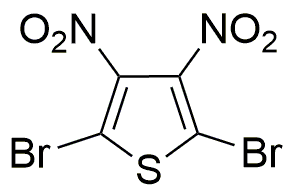2,5-Dibromo-3,4-dinitrothiophene is widely utilized in research focused on:
- Organic Electronics: This compound is used in the development of organic semiconductors, which are essential for creating flexible electronic devices such as organic light-emitting diodes (OLEDs) and organic solar cells.
- Pesticide Formulation: It serves as an intermediate in the synthesis of agrochemicals, particularly in developing effective pesticides that target specific pests while minimizing environmental impact.
- Material Science: The compound is explored for its properties in creating advanced materials, including polymers that exhibit enhanced thermal and electrical conductivity.
- Analytical Chemistry: It is utilized as a reagent in various analytical methods, aiding researchers in detecting and quantifying other chemical substances in complex mixtures.
- Pharmaceutical Development: The compound is investigated for potential applications in drug formulation, particularly in creating compounds that can target specific biological pathways.
General Information
Properties
Safety and Regulations
Applications
2,5-Dibromo-3,4-dinitrothiophene is widely utilized in research focused on:
- Organic Electronics: This compound is used in the development of organic semiconductors, which are essential for creating flexible electronic devices such as organic light-emitting diodes (OLEDs) and organic solar cells.
- Pesticide Formulation: It serves as an intermediate in the synthesis of agrochemicals, particularly in developing effective pesticides that target specific pests while minimizing environmental impact.
- Material Science: The compound is explored for its properties in creating advanced materials, including polymers that exhibit enhanced thermal and electrical conductivity.
- Analytical Chemistry: It is utilized as a reagent in various analytical methods, aiding researchers in detecting and quantifying other chemical substances in complex mixtures.
- Pharmaceutical Development: The compound is investigated for potential applications in drug formulation, particularly in creating compounds that can target specific biological pathways.
Documents
Safety Data Sheets (SDS)
The SDS provides comprehensive safety information on handling, storage, and disposal of the product.
Product Specification (PS)
The PS provides a comprehensive breakdown of the product’s properties, including chemical composition, physical state, purity, and storage requirements. It also details acceptable quality ranges and the product's intended applications.
Certificates of Analysis (COA)
Search for Certificates of Analysis (COA) by entering the products Lot Number. Lot and Batch Numbers can be found on a product’s label following the words ‘Lot’ or ‘Batch’.
Número de catálogo
Número de lote/lote
Certificates Of Origin (COO)
This COO confirms the country where the product was manufactured, and also details the materials and components used in it and whether it is derived from natural, synthetic, or other specific sources. This certificate may be required for customs, trade, and regulatory compliance.
Número de catálogo
Número de lote/lote
Safety Data Sheets (SDS)
The SDS provides comprehensive safety information on handling, storage, and disposal of the product.
DownloadProduct Specification (PS)
The PS provides a comprehensive breakdown of the product’s properties, including chemical composition, physical state, purity, and storage requirements. It also details acceptable quality ranges and the product's intended applications.
DownloadCertificates of Analysis (COA)
Search for Certificates of Analysis (COA) by entering the products Lot Number. Lot and Batch Numbers can be found on a product’s label following the words ‘Lot’ or ‘Batch’.
Número de catálogo
Número de lote/lote
Certificates Of Origin (COO)
This COO confirms the country where the product was manufactured, and also details the materials and components used in it and whether it is derived from natural, synthetic, or other specific sources. This certificate may be required for customs, trade, and regulatory compliance.


